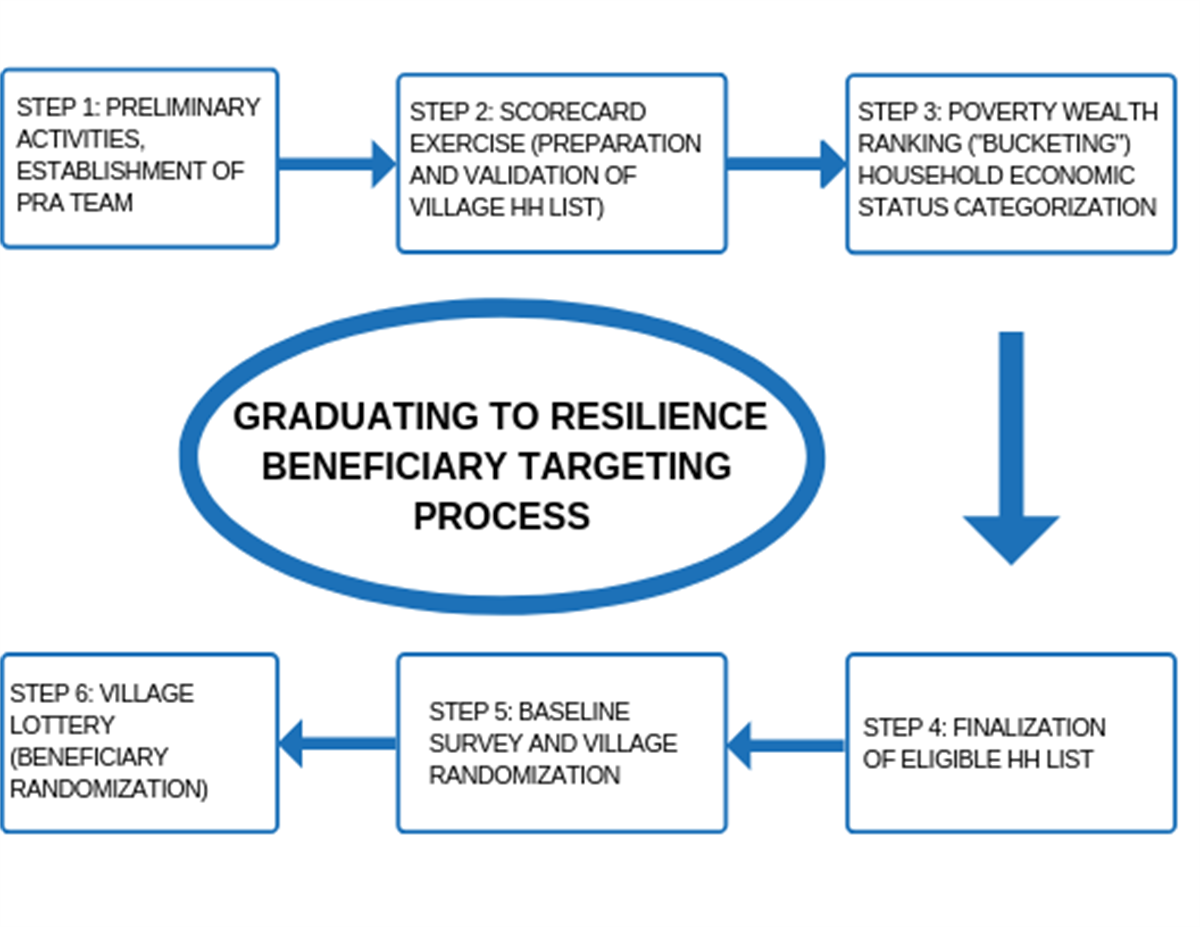From June-August, 2018, Graduating to Resilience conducted targeting exercises to identify eligible beneficiaries for the Activity. As part of this process, the team conducted two pilots and held After Action Reviews (AARs) daily to address challenges as they occurred. The Activity used a two-part Participatory Rural Appraisal (PRA) approach to identify eligible households, comprised of both Social Mapping and Poverty Wealth Ranking (PWR) exercises. This methodology relies heavily on community participation and engages community members and leaders in beneficiary selection, not only as sources of information but also as partners in gathering and analyzing information.
The Social Mapping component involves walking through each village with leaders and community members to physically locate every HH and conduct a brief quantitative survey to assess the wealth of each HH. PWR brings together community members and leaders and allows for representatives to define wealth rankings (extremely poor, poor, moderate, and rich) and place every member of the community into one of the corresponding ranking based on their own wealth definitions.
Pilot testing of PRA methodology for targeting
The Activity team consulted extensively with the external evaluator as well as government stakeholders at all levels to refine the PRA methodology for targeting and ultimately for the identification of eligible households. In Figure 1, the main steps of the process are listed, as well as a quick summary of the results from each pilot.

The table below highlights some key lessons learned and their solutions implemented through the iterative learning process.

Scaled-up targeting approach
After Pilot 2, the revised methodology was used at scale to identify eligible households for participation in the first cohort of the Activity, inclusive of a control group.
The Activity identified 25,140 eligible [1] households through an innovative, participatory, and community-led process. 11,536 (46%) of these households are within the refugee settlement, whereas 13,604 (54%) are from the host community. A total of 195 villages (45 in the refugee settlement and 150 in the host community) have been reached by this exercise. Villages will be assigned as “treatment” or “control”, and from within the “treatment” villages a total of 6,600 households will be assigned to the three treatment arms. An additional 4,400 households will constitute two equally-sized control groups; 2,200 households in the “control” villages, and another 2,200 households in the “treatment” villages. This second control group will allow for the detection and measurement of possible spillover effects from the treatment groups.
As shown in Table 2, the participatory approach to targeting is resource-intensive, both in terms of staffing and time.


Next-steps to enrolment
The PRA methods described were not the end of the targeting effort. Once lists of eligible households were completed by the Activity team, they were handed over to the external evaluator for review and preparation for the baseline survey implementation. Subsequently, the external evaluator randomized villages into treatment and control categories and provided those results to Graduating to Resilience. Once baseline data collection is completed, the Activity team will return to each and every village and conduct a public lottery to assign selected households to one of the treatment arms or to the control group

Summary lessons learned
The lessons learned from the two pilots underlined the importance of the involvement of the local community, especially from the very beginning. Local leaders helped to mobilize community members and to answer questions, reducing the perception of the exercise being a census. The Activity benefited from the deep understanding of locally conceptualized poverty classifications to better align project objectives to reach the extreme poor in both refugee and host communities.
Reliable community lists and mapping of the household locations were difficult in both settings; direct observation through visiting each household should be carried out to ensure that extremely poor households are not excluded. This is essential as households frequently move from one location to another.
In addition to the community engagement, another positive aspect of the targeting process has been the engagement of coaches in the PRA. This early engagement allowed coaches to become familiar with the communities with whom they will work, meet and work closely with Graduating to Resilience staff prior to implementation, and increase their knowledge of the selection process should questions arise at later times.
On the other hand, having coaches, numbering just under 200, on board very early on carries a cost implication. As part of the external evaluation, the Activity will conduct a cost-benefit analysis at the end of the activity and will see if this information can be determined. Stay tuned for more information regarding lessons learned from hiring over 260 local staff to fill the coaching and community based trainer positions.
[1] Graduating to Resilience targets poor and extremely poor, but economically active households which are also chronically food insecure.